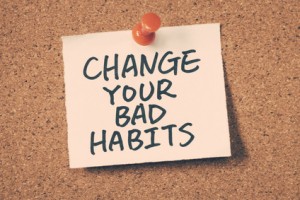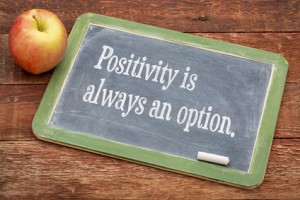Ditch Bad Habits This Year
 Can 2017 be the year that you get rid of bad habits and make real strides forward? It can, but it requires new thinking. Moving forward means we have to drop some of the things we hold onto, even though they may be things we’ve come to expect, and accept. I’m one of the worst at letting go! I know it. The people around me know it. But sometimes, it seems that I just HAVE to keep those old habits going. Not this year. I’m going to make a concerted effort to let go of these bad habits. Do you want to join me? They say that if we join forces, there’s a better chance we’ll succeed in ditching our bad habits. Here’s a list of bad habits often seen in the workplace.
Can 2017 be the year that you get rid of bad habits and make real strides forward? It can, but it requires new thinking. Moving forward means we have to drop some of the things we hold onto, even though they may be things we’ve come to expect, and accept. I’m one of the worst at letting go! I know it. The people around me know it. But sometimes, it seems that I just HAVE to keep those old habits going. Not this year. I’m going to make a concerted effort to let go of these bad habits. Do you want to join me? They say that if we join forces, there’s a better chance we’ll succeed in ditching our bad habits. Here’s a list of bad habits often seen in the workplace.
Striving for perfection. While we all want our work to be correct, striving for the perfect result does not pay off. We lose time, the project takes longer to complete and the end result is not significantly improved. Instead, we overstress ourselves and those around us.
Addiction to our phones. Have you noticed sometimes when you’re out, that everyone’s on their phones? Whether they’re playing games, on social media or checking email, it’s a habit most of us need to break. There’s a difference between responsible communication and not interacting with the people around you.
Accepting a high level of stress. I blame this one on the “east-coast-culture.” Truthfully though, it’s prevalent everywhere. There is so much going on in our lives that it’s easy to accept a high level of stress as normal. We sometimes contribute to our own stress. Even before we begin work, our thinking turns negative. We say to ourselves, “I’ll never get this all done today!” It’s up to us to break our own stress habit. We can turn our attitude around by saying “Let’s see how much I can get done on this project today.”
Sticking with the way we’ve always done things. There are so many tasks that can be done faster and more efficiently today than in the past. These tasks may require learning new technology – which can be frightening to many. But spending time to sit down with someone who can explain a faster way of accomplishing a tasks broadens our minds and keeps us current.
Acting too quickly. When I can’t answer emails quickly, I notice that some problems solve themselves. The same thing happens in meetings. When we listen to the discussion for a while, rather than come to a quick decision, the best way to solve the problem surfaces naturally. Holding back, rather than jumping in too quickly, is often more effective.
Follow me on Facebook, Twitter and LinkedIn this month. I’ll provide more information on bad habits we should kick and how to succeed! Share your ideas with me!
Steps You Can Take To Break Bad Habits
 Looking at the list of bad habits commonly found in the workplace, I’m pretty determined that I’d like to break myself of at least some of them. To be successful, the experts say to follow these steps.
Looking at the list of bad habits commonly found in the workplace, I’m pretty determined that I’d like to break myself of at least some of them. To be successful, the experts say to follow these steps.
- Find a partner who will work with you to help ditch these bad habits.
2. Put a voice to your bad habit. Admitting your habit to someone makes you accountable. Sharing your habit with a friend will also make you more conscious of it when you fall back into the habit.
3. Write it down. Whatever your bad habit, when you find yourself repeating it, write it down. Write down how you feel – what’s going through your head. This action will also make you more aware of your bad habit before it happens.
4. Think of a good response for the next time. If your bad habit is accepting too much stress, try a one-minute meditation. Or get up from you chair and take a 5-minute walk. Find something that can replace your bad habit.
5. Reward yourself. Start small. How can you reward yourself when you’ve avoided the habit? Then keep rewarding yourself and plan for a big reward when you finally feel like you’ve ditched the habit for good.
Follow me on Facebook, Twitter and LinkedIn this month. I’ll provide more information on bad habits we should kick and how to succeed! Share your ideas with me!
Positivity
 Did you happen to notice around the end of 2016 how many people were looking forward to saying goodbye to the year? 2016 was a rough one for many folks. It was a divisive political environment, we said goodbye to many sports and entertainment personalities and there were too many tragedies broadcast over the air waves.
Did you happen to notice around the end of 2016 how many people were looking forward to saying goodbye to the year? 2016 was a rough one for many folks. It was a divisive political environment, we said goodbye to many sports and entertainment personalities and there were too many tragedies broadcast over the air waves.
But turning the calendar page from one year to the next does little to change our overall emotional well-being. There are lots of things we can all do to improve our mood and general outlook. I like this article from Fast Company on 10 Science-Backed Ways to Be More Positive in 2017. There are some simple ideas here, such as breathing deeply, scheduling our own self-care sessions, volunteering time and meditation. Everyone can practice some of these methods to help improve your outlook.
For me, part of being positive comes from recognizing the things that I should be grateful for. A gentle reminder to ourselves makes us realize our good fortune. Things that I’ve stressed about become less annoying when I remember how lucky I am.
I also search out positive people. Have you ever noticed how much better you feel after you’ve been around a person who inspires you? A happy, positive person generally spreads happy thoughts around the office.
Even when you adopt a few habits to increase your positivity, there are times in our lives, especially in today’s uber-connected world, when things can overwhelm us. When that happens, it may be time to change the way we live and work. We are constantly connected with our work, our home and our national and global news sources. It’s easy to feel bogged down. Maintaining positivity might mean disconnecting with the world around is – even if it’s only for a short time.
Try opening your email just twice a day. Constantly communicating with co-workers may not be the ideal situation. Think about putting your phone down when you get home in the evening, and try not to look at it until after dinner. Short breaks from the constant clutter that comes our way can be quite effective in relieving our stress and shifting our outlook from gloomy to glad!
And one more tip. So often, we measure our value by productivity. But when we try to battle three things at once, we can end up even more frustrated. Instead, focus on getting one thing done at a time. As you arrive at work each day, say to yourself – “What is the most important thing for me to do today?” Make that one action your priority and get it done. Even if it’s the ONLY thing you accomplish that day, you can positively remember that you did accomplish your most important task. And then put the rest aside, there’s another day to tackle the next project on your list!
Six Things You Can Do To Be More Positive
 These tips won’t cost you a dime. And they’re easy, so time is no excuse!
These tips won’t cost you a dime. And they’re easy, so time is no excuse!
- Purposefully Breathe. Long breaths in, long breaths out. Repeat them 5 times.
- Turn off your phone. Maybe just for an hour. Watch how much you get done!
- Reward yourself. A hot bath, a walk at lunchtime, music while you cook dinner, 10 pages of your favorite book – all of these ideas will bring a calmness to your life.
- Choose a word every day that lightens the mood and brings soothing thoughts. Beach. Snow. Faith. Peace. Whatever the word is, take time during your day to consciously think about it for a minute or two.
- Get up, walk around, roll your shoulders. The simple act of pushing yourself away from your desk and computer will relax you and make you think differently.
- Thank someone. At home or at work, giving a sincere thanks to someone not only lightens that person’s day, but yours also.
Doing What Matters
 Ever since childhood I remember my mom saying:
Ever since childhood I remember my mom saying:
“Get a good education. That is something that no one can take away from you.”
In my parent’s house, college was mandatory. There were 5 children in the house, and all of us have some level of post high school learning – whether it be a college degree or specific military training. As a matter of fact, my youngest sibling excelled at maintaining the Army’s Black Hawk and served in Desert Storm. We are all so very proud of him.
When I received my MBA, of course my family was proud of me, but actually it felt quite normal. After all, that’s what we were supposed to do! I went on to be adjunct faculty and career counselor. Eventually, I started my own business – and now it’s going on 25 years!
It seems appropriate then, that my business is about educating and training people on how to become an effective leader. We help our clients find “What Matters to Them” and at the same time, I’m “Doing What Matters” to me.
Additionally, as a mentor for high school high achievers, I have seen so many extremely smart and ambitious youth who want to go to college. The problem is that there are very limited resources to take advantage of – short of their parents having to go into deep debt. It was different when I went to college. Then, there was an abundance of FREE college money. Indeed, I went to the University of Maryland – tuition-free! It appears that those days are long gone. So many kids are side-lined from fulfilling their dreams, realizing their purpose, for lack of money.
And so, I have now entered into my Next Life – Director of Let’s Go! In short, I started Let’s Go! as a non-profit in order to provide resources for ambitious and high achieving youth who just don’t have the means to take advantage of post-high school learning as I did. Let’s Go! – a highly competitive program – will not only provide financial resources for these youth, but it will also provide leadership and life skills. I’ve come full-circle. Once again – Doing What Matters. What matters to YOU?
Recognizing Accomplishments
 November has blessed us with some wonderful weather and forceful sunshine! Even if it were not the month that we traditionally give thanks, we might be thankful each time we go out the door. When we really sit down and think about it, we realize that it’s often the littlest things – the things we sometimes take for granted – that we are most thankful for.
November has blessed us with some wonderful weather and forceful sunshine! Even if it were not the month that we traditionally give thanks, we might be thankful each time we go out the door. When we really sit down and think about it, we realize that it’s often the littlest things – the things we sometimes take for granted – that we are most thankful for.
I once had a boss who rarely acknowledged accomplishments. He thought accomplishments were expected, and praising an accomplishment might make someone sit back and not work very hard. I’d often shake my head, wondering, what was he thinking! In truth, when we recognize accomplishments, we provide a lift to the person or team we recognize. Instead of sitting back and doing nothing, a little recognition usually makes people work harder! They are grateful – grateful to have a job and grateful that hard work is recognized.
So in this month of November, as the days grow shorter and the year-end approaches, let’s remember the things we can do to celebrate successes. Here’s a list. How many can you practice before December 31st?
- Recognizing success is often about doing what matters. It’s taking your job seriously and performing the work that is important to the mission. Do you have a manager or team leader who has battled through opposition? Or maybe led a team with dignity? Celebrate their success with a hand-written note. A simple Thank You will prove to be a happy diversion for a job well done.
- Celebrating the entire team. Besides the pessimistic boss described above, I also had one that understood how important it was to recognize the team. So he would arrange an event. Something simple. He’d bring in root beer and vanilla ice cream and make root beer floats after lunch! Or he stopped by the donut place and grab a large container of coffee and donuts. Whatever he planned, it came with a public display of recognition. Wow, did that make us feel good!
- Perk up someone’s day with a small card from Starbucks. It might just have $5 on it, but you end up making that person feel good twice – when you give it to them and make note of why he/she deserves it, and when they use the card!
- Set up a Brag Board. This is great if you have a team. Ask them to bring something that can be added to a poster that reminds them of the job they’re working on. Make it known that you want brag on them a little and want visitors to see what’s being accomplished. The board will grow as more contributions come in, making it a topic of interest for a while, and a constant reminder that you wanted to brag!
- Finally, just say it. Say Thank You. Genuinely given, a simple thank you can have as great an impact as any of the other suggestions above.
Need help building a team? Or building a positive culture. Why don’t you give us a call and we’ll get started now so that 2017 becomes the year of achievements for your organization. Give us a call at 301-670-0051.
Planning for the Year Ahead
 Your business plan is essential to the success of your organization. Your plan is your map. It not only describes what you are going to do, but also provides a direction on how you and your team will get there. Without this execution strategy, your plan is meaningless.
Your business plan is essential to the success of your organization. Your plan is your map. It not only describes what you are going to do, but also provides a direction on how you and your team will get there. Without this execution strategy, your plan is meaningless.
Having a solid plan for how your department or organization will run is a key component of its smooth and successful operation. Your plan is critical to achieving success. It’s important to you, your managers and equally important for the staff you lead. Everyone needs to understand how your organization should be run on a daily basis. Your thoughts and expectations should be clearly defined.
Obviously, for smaller organizations, the business will be far more streamlined and less complicated than it is for larger ones, but your plan still needs to demonstrate an understanding of the work required and how you’ll handle the work flow.
So let’s discuss how you can put together a plan that is organized and understood. Your plan should contain the following items.
Mission. Your mission should be clearly defined so that everyone knows what your organization or department does and why you do it. You may be part of a broader mission, but your organization should still have its own mission. A clear and thoughtful mission statement creates a connection with the organization and the people you serve.
Keys to Success. Organizations have a few key factors that lead to success. What are the things your organization must do to be successful? List these factors in your plan.
Analysis of your organization’s position. Think about your organization’s position or circumstances. A good tool to use is a SWOT analysis – Strengths, Weaknesses, Opportunities and Threats. What is the present position of your organization and how does it need to grow, or change?
Description of Services. What are the services you offer to the rest of your organization? A clear description of these services, what they do and the benefits they provide are important. You may provide a variety of services, depending on whether your customers are internal, external or both.
Delivery Requirements. You must define the requirements of the services you will deliver. These requirements may be set by your team or defined by an outside source. In either case, deciding the measurements and stating them within your plan is important to tracking success. Your next step is to define the responsibilities around each step and the tactics you will take to accomplish your goals. These requirements will play a key role in helping you analyze the success of your staff and the organization as a whole.
Implementation Plan. How are you going to carry out your plan to provide the services needed by others? Your plan should be strategic. Each task should bring you closer to accomplishing the plan.
Objectives. There is a reason why you are taking certain steps, or actions. These are the objectives – and should be stated in your plan. The objectives also help to define success factors.
Personnel and Expertise Needs. Your managers and staff carry out most of your plan. It’s important that everyone understands his or her responsibilities, as well as the qualifications for doing the job. Our next article provides more detail on roles and responsibilities within the plan.
Leah M. Joppy & Associates would like to be your partner in your strategic plan. We provide training – training for leadership, professional and personal development, and many different types of computer training. Give us a call at 301-670-0051 and let us help you achieve faster results with your team.
Utilizing Technology
 In this day and age, every organization should leverage technology in the workplace. But it’s one thing to have technology solutions and quite another to make sure the solutions are being used to their full extent. Using technology is not just about having computers and an internet connection in the office. It’s also about having a deep understanding of the various software solutions available to employees. Having a complete working knowledge of various applications will significantly affect employee productivity. The knowledge and understanding of these programs also breaks down barriers to mobility. Work-related documents and information can be accessible on the road, as well as in the office.
In this day and age, every organization should leverage technology in the workplace. But it’s one thing to have technology solutions and quite another to make sure the solutions are being used to their full extent. Using technology is not just about having computers and an internet connection in the office. It’s also about having a deep understanding of the various software solutions available to employees. Having a complete working knowledge of various applications will significantly affect employee productivity. The knowledge and understanding of these programs also breaks down barriers to mobility. Work-related documents and information can be accessible on the road, as well as in the office.
Wasted time and energy add up over time. Keeping employees productive and efficient should be an important objective for all managers. Looking at a normal business environment, there are many tools that can help organizations take control of their time and improve efficiencies. Here are some examples.
- Collaboration is key in the workplace. Increased connection in the workplace promotes extended communications among co-workers, clients, and industry professionals. The right technology can eliminate multiple emails flying back and forth between employees. You can also eliminate any “double” work, where 2 or more people may be making corrections on the same document. Try using collaborative tools such as webinar conferences, skype, video chat or an intranet where employees can share files. Applications such as OneNote, Outlook, Office 365 and Project can keep everyone informed more efficiently. Many organizations are adopting SharePoint for even greater project management oversight.
- Document Management. When cloud services became available, document management got a whole lot easier. Employees can work live with collaboration tools like Google Docs. This tool allows multiple people to work on a project together without emailing multiple versions back and forth.
- The collection of data and the retrieval of information is key in today’s workplace. At the very minimum, employees should have a working knowledge of Excel and know what capabilities exist within the application. Other programs, like Sharepoint, are capable of more complex data entry and retrieval.
- Tools that are common to most workplaces – including most Microsoft Office applications – are instrumental in providing an effective solution for organizing the data collected to solve many problems.
Effective Use Of Technology In The Workplace. Technology has afforded most organizations with the opportunity to have a higher level of communication and connectivity than we’ve had before. We have, through these technologies, the ability to connect instantly with others, regardless of where they work or live. Employees have the ability to communicate face to face – even when they reside in different parts of the country – or world!
Technology is a powerful tool that can be used to foster relationships, effectively manage time, improve organization and bridge the gaps of communication. The key to the powers of technology lies in the knowledge and confidence of your employees. The level of knowledge of a particular application depends on the individual and his or her work. Some of us take longer to understand and feel comfortable with programs than others. By providing workshops to reinforce what we know, and open the door to other possibilities, we grow the productivity skills of our organization.
Intelligent Workshops
Our workplaces today have had an eruption in technology. How we work and how we deliver our products and services has shifted. We need to maximize the ability of our employees in order to create efficiencies. The workshops listed below help to break down barriers to productivity.
Give us a call at 301-670-0051 and let us help you achieve faster results with your team.
| Word | Excel |
| Access | PowerPoint |
| Outlook | InfoPath |
| OneNote | Project |
| Publisher | WordPerfect |
| Crystal Reports | Adobe Professional |
| SharePoint | SharePoint Designer |
| Office 365/One Drive | Skype for Business |
| Visio |
Connecting With People
 In this fast paced world of email and text messaging, we somehow leave out the “connecting” part of our communications. And yet, the connecting part is very important to our own success. How we relate to others, and communicate our desires, makes a huge difference on how the message is received. Have you ever noticed that HOW we are asked to do something, either makes us excited to do it, or makes us roll our eyes and dread the project? It’s all about understanding how human behavior works. We can elevate the performance of those around us if we CONNECT.
In this fast paced world of email and text messaging, we somehow leave out the “connecting” part of our communications. And yet, the connecting part is very important to our own success. How we relate to others, and communicate our desires, makes a huge difference on how the message is received. Have you ever noticed that HOW we are asked to do something, either makes us excited to do it, or makes us roll our eyes and dread the project? It’s all about understanding how human behavior works. We can elevate the performance of those around us if we CONNECT.
In your job, and in your future. Recently I read an article about being a successful entrepreneur. The author mentioned that one of the keys to success revolves around the network of the business owner. Those owners who had a more varied network, with closer ties, were more successful. It wasn’t the NUMBER of contacts that determined the success of the owner, but rather the variety of contacts and the depth of the relationships. Some of the most successful entrepreneurs had close contacts in many different areas – people with whom they could discuss problems, or bounce around some ideas. The sincere advice that was given from this network helped the business owner find answers to various problems.
Not a business owner. Whether you work for the government or have a job in corporate America the concept of keeping close ties with a varied list of contacts is not a bad idea. Even retiring successfully and happily may be influenced by your circle of contacts.
Are you listening? When we truly connect with someone, even if it’s someone we’ve just met, the person we’re talking to feels involved. The connection is subtle. Our body language gives us away. Sometimes I see it at networking events. I’m talking to someone, but I see him or her looking casually around the room. Obviously, we’re just NOT connecting. When we’re not truly paying attention, the person we are talking to reads our body language. And not paying attention is a real hit to the person’s confidence.
Telling stories. I have a friend who always interrupts my conversation with a story about what has happened to them. Admittedly, the stories she tells are always on topic to the discussion we were having, but it’s her story. So my conversation or my discussion gets turned around and is quickly forgotten. The focus is now on her!
Those little words. I notice this mostly when I’m on the phone with someone, but it can happen in person too. The person I’m talking to may use words like, “Uh-huh,” “Really,” “gosh,” or “interesting” – all words that signal to me that they are not really involved in my conversation. Something is distracting them. I’m not connecting.
We all bring value. Can we just agree to that statement? Instead of trying to impress everyone with our knowledge and expertise, it’s so refreshing when someone openly admits that they learned something new for the first time! Such a response makes the person talking feel valued.
Talk about the familiar. In some situations, you may feel out of your element. You walk in a room and don’t recognize anyone, or you see that you are outnumbered – you’re a women and the room is almost entirely men (or vice versa). The situation can be nerve wracking. So rather than try to come up with something clever, just be yourself. Talk about something that interests you – a recent movie, a team that you are following, or an upcoming vacation. People are just trying to connect with you, and even if you never mention your expertise, you’re connecting with them on a more personal level – which is actually better!
Does your organization lack connectivity? Better communication leads to less conflict, decreased ‘silos’, a sense of trust , better collaboration and more fulfilling work. Let us help elevate the performance of your team. Give Leah M. Joppy & Associates a call at 301-670-0051 or email leah@lmja.com and let’s discuss solutions that work!
